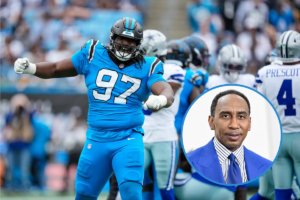Tiger Woods has faced more comebacks than most athletes could imagine, but his latest medical battle has reignited fears that even his legendary resilience may have reached its breaking point.
The 49-year-old underwent his seventh back surgery, a lumbar disc replacement at the L4/L5 level, in New York on October 11, the latest in a string of operations spanning nearly three decades.
Performed by Dr. Sheeraz Qureshi at the Hospital for Special Surgery, the procedure addressed a collapsed disc and fragments compressing the spinal canal, which had severely limited Woods’ mobility in recent months.
“After experiencing pain and lack of mobility in my back, I consulted with doctors and surgeons to have tests taken,” Woods wrote on X. “I opted to have my disc replaced yesterday, and I already know I made a good decision for my health and my back.”
While Woods expressed optimism, those around the game were less confident. Analysts have described the timeline as “ominous,” with Golf Digest senior writer Jaime Diaz outlining the grim reality of what this surgery could mean for Woods’ career.
“Probably,” Diaz admitted when asked if golf might be nearing the end of seeing Woods compete regularly. “Right now, the issue is managing pain so that he can swing a golf club with some freedom. But at this stage, it’s about survival, not titles.”
The limits of a lifetime comeback story
For a man who has defined golf’s modern era, Woods’ medical history reads like a timeline of triumph and torment.
The 2017 fusion surgery at L5/S1 saved his career, allowing him to walk and play without chronic pain for the first time in years. That comeback culminated in his unforgettable 2019 Masters victory, one of the most emotional moments in sports history.
But the same procedure that resurrected his career also sowed the seeds of future trouble. “That was always going to be a problem,” Diaz explained. “Once you fuse one area of the spine, the level above it takes on all the pressure and stress. Eventually, it breaks down.”
That prediction has now come true. The L4/L5 disc, directly above the fused segment, finally failed, requiring replacement. The situation is complicated by Woods’ other physical struggles.
Earlier this year, he ruptured his left Achilles tendon during training, effectively ruling him out for much of the 2025 season. This latest setback ensures he will miss the rest of the year entirely, including his annual Hero World Challenge and the PNC Championship he traditionally plays alongside his son, Charlie.
It also casts doubt on his involvement in the upcoming TGL golf league launch, a project he co-founded and was expected to headline this winter.
Hope, pain, and the question no one wants to ask
Despite the dire outlook, few are willing to count Woods out completely. “If he can find a way to be pain-free, he’s got years of golf ahead of him,” Diaz said. “Phil Mickelson won a major at 51. If Tiger can walk 72 holes without pain, he’ll play again.”
That sliver of hope is built on precedent. Woods has defied medical logic before, from winning the 2008 U.S. Open on a broken leg to walking Augusta National just 14 months after a car crash that nearly cost him his right leg. His ability to endure pain and perform under impossible conditions is central to his myth.
Yet the tone surrounding this surgery feels markedly different. At 49, the question isn’t whether Woods can still compete, but whether he should. Even his closest peers have expressed concern that another comeback could come at too high a physical price.
“I think everyone should just be grateful that he’s still here,” Rory McIlroy said after Woods’ 2021 accident. “Golf has always been better with Tiger, but his health is what matters most now.”
That sentiment resonates louder than ever. Woods‘ world ranking has plummeted outside the top 300, and he hasn’t completed a full PGA Tour event since early 2024. Every surgery brings new uncertainty, not just about performance, but about his long-term quality of life.
Still, Woods’ competitive fire refuses to dim. “I’ll play as long as I can play and I feel like I can still win,” he said years ago, a mantra that continues to define his approach. Whether that drive will carry him through another long recovery remains to be seen.
For now, the only certainty is that Tiger Woods‘ future, both on and off the course, hangs in the balance. And as the golf world holds its breath once again, one question looms larger than any leaderboard: how many more miracles does he have left?
Read the full article here










